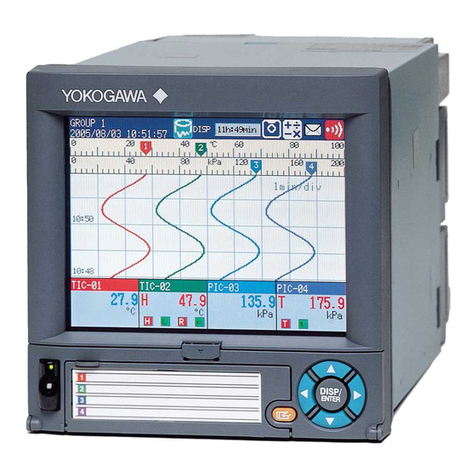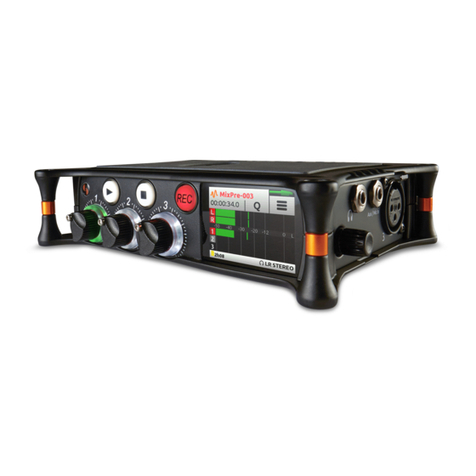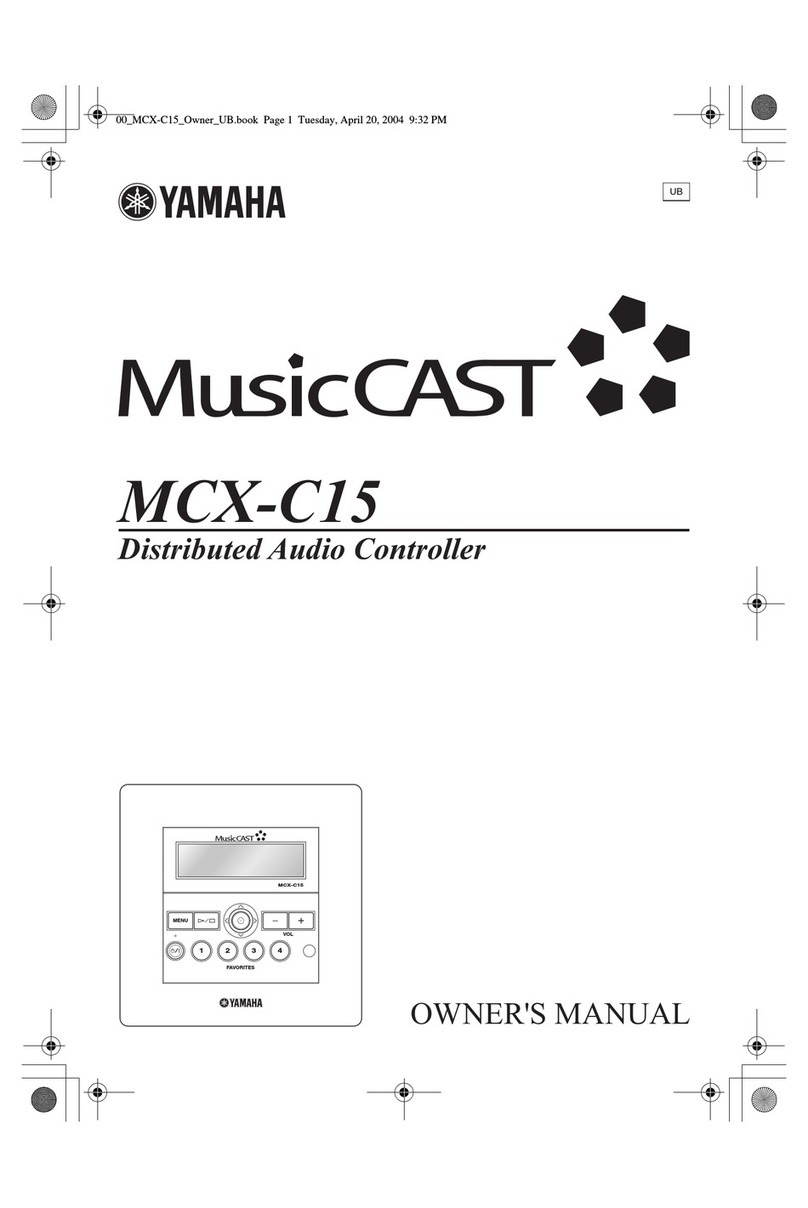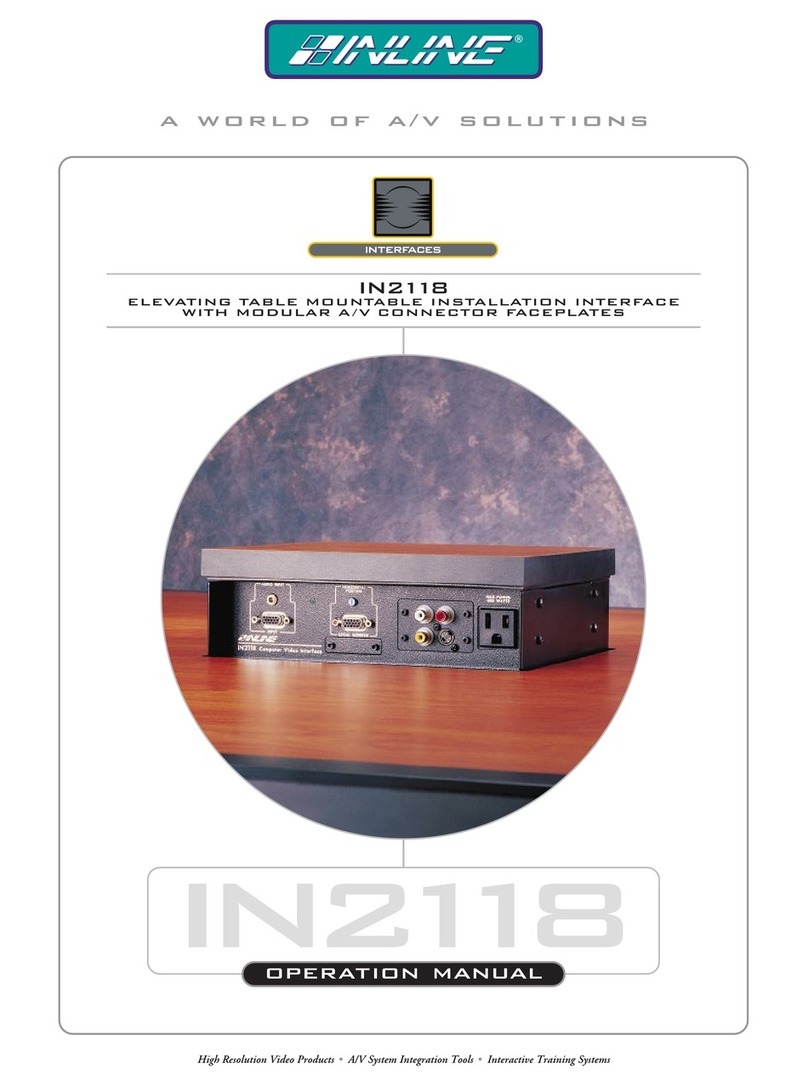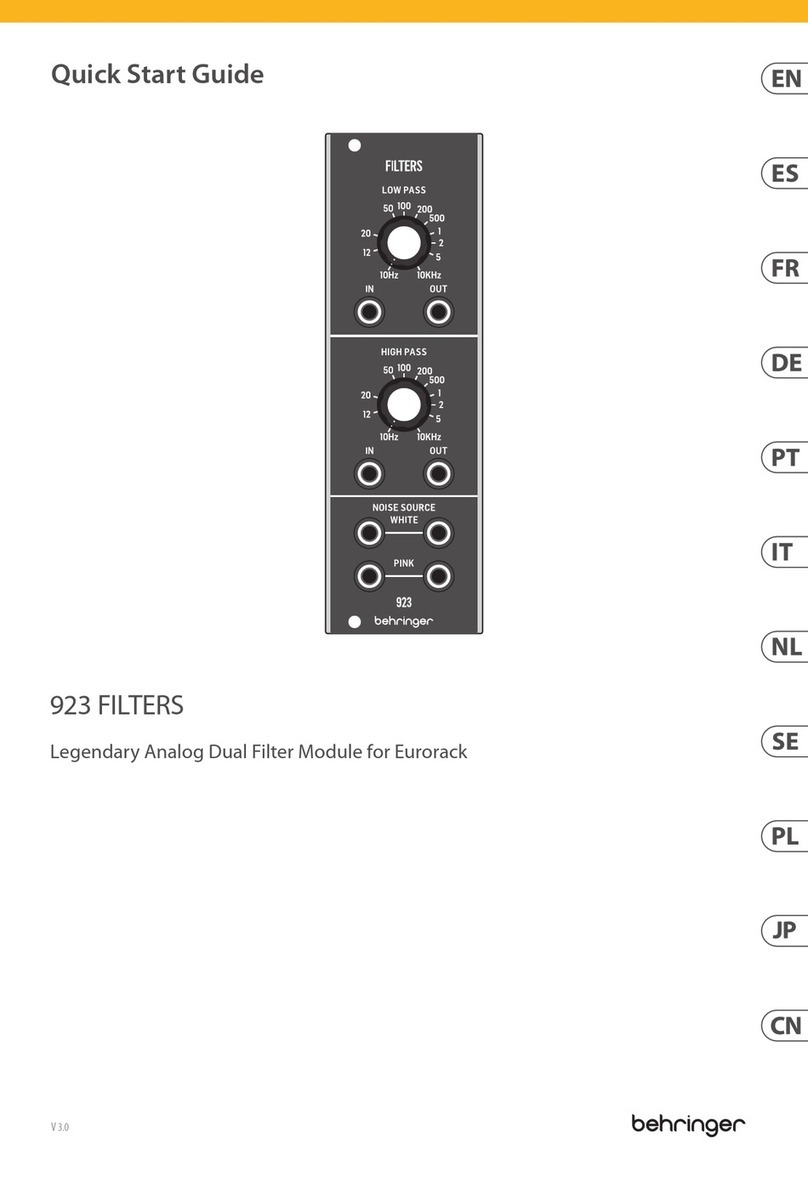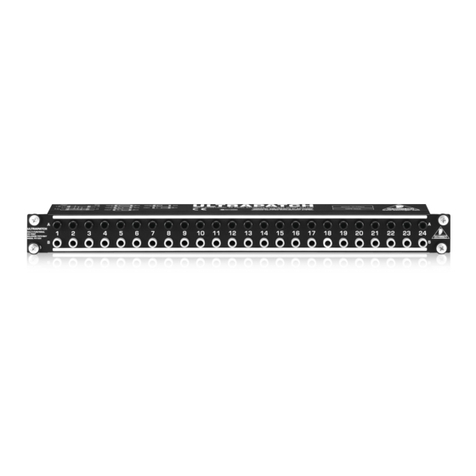Noise Engineering Loquelic Iteritas User manual

Overview
Type VCO
Size 10HP Eurorack
Depth
Power 2x8 Eurorack
+12 mA 150 / 80
-12 mA 5
Loquelic Iteritas is a digital VCO with interpretations of three classic
synthesis algorithms involving dual pitch control. It creates a huge variety
of sounds parameterized by four tone and two pitch controls.
1
Noise Engineering
Loquelic Iteritas
Complex Digital Oscilator
+5 mA 0 / 90 (optional)
“I could kill someone with that”
-- DJ Surgeon
“This thing sounds fucking amazing
lots of stuff I’ve never heard before”
-- Surachai
1 Inch
Before Serial 555 After Serial 555

Patch Tutorial
Other interesting effects can be created by controlling the pitches
independently (by default the 1v/8va inputs are normaled to each other). For
instance, using a Tonnetz Sequent to produce musical intervals produces
interesting results.
e easiest way to get to know Loquelic Iteritas is to turn the knobs and
listen. Connect the output to your mixer and start twiddling.
Loquelic Iteritas is about continuous tone control. Hook any LFO up to any
of the four tone control inputs (Morph, Fold, Modulate, Damp).
2
Noise Engineering
Loquelic Iteritas
Complex Digital Oscilator

Interface
e pitch of oscillator A can be controlled by the 1v/8va input and offset by
it’s coarse and ne knobs. e pitch inputs are cross normaled.
Pitch B
e pitch of oscillator B can be controlled by the 1v/8va input and offset by
it’s coarse and ne knobs. e pitch inputs are cross normaled.
Pitch A
is a tone control. Consult the following pages detailing each mode to nd the
behavior of this knob in the specic mode.
Damp
is a tone control. In all modes it controls phase modulation between the two
pitch oscillators.
Fold
Algorithm
Sync will reset the state of the oscillators on a rising edge. Used for sync
modulation. is jack was added starting at serial 700.
Out
Mod
is a tone control. In all modes it controls the waveform of the oscillator
continually varying between sin, triangle and saw.
is a tone control. In all modes it controls the threshold of the wavefolding.
Morph
selects which algorithm is used. ese are detailed on the following pages.
Master
Sync
Out is the AC coupled audio output.
Voltages
controls the sync of the oscillators. When in the middle position both
oscillators are free running. When A is selected oscillator B will sync to
oscillator A. when B is selected A will sync to B.
e CV inputs respond to 0-5v, except for pitch, which responds to 0-8v. e
Sync input responds to a rising edge of around 2v.
3
Noise Engineering
Loquelic Iteritas
Complex Digital Oscilator

Loquelic Iteritas can run it’s processor on the 5V eurorack power rail to
reduce noise and load on the 12V bus. ere are three different versions of
the CPU board two which use a switch to select and one which uses a
jumper. For the swtich versions gently push the switch tab in the direction of
the desired rail to use. For the jumper version put the jumper from the center
pin to the pin marked with the rail that is deesired.
Noise Engineering
Loquelic Iteritas
Complex Digital Oscilator
Calibration
Voltage Supply
4
Loquelic Iteritas is best calibrated using a stroboscope and tuning octaves
across the pitch range. Each pitch input has as separate calibration. e
pitches can be isolated from each other by using the master switch to force
the base pitch to be determined by only one input.

5
Algorithm: VO
Kaegi, Werner, and Stan Tempelaars. "Vosim-a new sound synthesis system."
Journal of the Audio Engineering Society 26.6 (1978): 418-425.
References
e VO algorithm is roughly based off of the VOSIM algorithm which I
discovered while reading Curtis Roads’s epic Microsounds. is algorithm
amplitude modulates a carrier by an exponential to create a more complex
harmonic structure. e simplest carrier is a sinusoid which produces a
spectrum with a Gaussian distribution centered on the carrier. More
complicated waveforms produce Gaussians around each harmonic,
producing spectra similar to comb ltered noise.
Interface
MORPH - changes the waveform of oscillator A
DAMP - sets the decay constant on oscillator B relative to its period
MOD - phase modulates oscillator A by oscillator B
FOLD - sets the wave fold threshold on the nal wave folder
Pitch A is the fundamental frequency of the carrier. Pitch B is the retrigger
frequency of the exponential decay.
Roads, Curtis. Microsound. MIT press, 2004.
Noise Engineering
Loquelic Iteritas
Complex Digital Oscilator

6
Algorithm: SS
References
Original equation:
Algorithm SS is a highly modied version of summation synthesis originally
developed by James Moorer. e premise comes from a simple mathematical
equality between an innite harmonic series and a relatively easy to compute
expression.
Modied Equation:
MORPH - changes the waveform of all oscillators
DAMP - sets the a parameter in the equality. This controls the generated
spectra with higher values producing higher power harmonics.
MOD - phase modulates oscillator A by oscillator B
Interface
FOLD - sets the wave-fold threshold on the final wave folder
is equation allows a wide variety of musical spectra to be produced by
only two parameters. Loquelic Iteritas generalizes the sinusoidal terms into
multi-waveform oscillators: two of these track the two input pitches while
the third tracks the difference of the two pitches and adds a wave folder for
more harmonics. In the equation oscillator A is the le sinusoidal term in
the numerator. Oscillator B is the sinusoidal term in the denominator.
Moorer, James A. "e synthesis of complex audio spectra by means of
discrete summation formulas." Journal of the Audio Engineering Society
24.9 (1976): 717-727.
Jolley, Leonard Benjamin William, ed. Summation of series. Courier
Corporation, 2012.
sin(θ β)
1+a−2a cos(β)
2
sin(Θ) − a sin(Θ−β)= ∑
∞
x=0
ax+x
sin(w t w t)
1+a−2a cos(w t)
2B
sin(w t) − a sin(w t−w t)
A A B = ∑
∞
x=0
ax
A+xB
Noise Engineering
Loquelic Iteritas
Complex Digital Oscilator

7
Algorithm: PM
e PM algorithm is a naive time-domain two-oscillator phase-modulation
implementation that combines both oscillators with amplitude modulation.
MORPH - changes the waveform of both oscillators
FOLD - sets the wave-fold threshold on the final wave folder
Interface
MOD - phase modulates the oscillators by each other
DAMP - blends between oscillator A and B through their product (AM)
Noise Engineering
Loquelic Iteritas
Complex Digital Oscilator

Sample Rate
Loquelic Iteritas uses a unique multisampling technique to make aliasing
more musical. By choosing a particular sample rate for a waveform that has a
harmonic structure (all overtones are integer multiples of the fundamental)
the alias power can be moved into frequencies that are also multiples of the
fundamental and therefore more musical.
is gets complicated when synthesizing two oscillators at different pitches
but using the same DAC. e compromise that Loquelic Iteritas makes is to
give up the notion of a xed sample rate and compute a time delay between
samples based on both oscillators. For the single oscillator case, this delay is
based entirely on pitch. If this delay is computed based on each oscillator's
pitch, both sample rates can be interleaved by checking which oscillator's
delay will be up rst. is oscillator is then updated to its next timestep and
an output value is computed based on both oscillator's output state. is
makes no guarantees about exactly where the aliasing goes. It is an attempt
to make the aliasing related in some way to the fundamental pitch.
Osc A
Osc B
Out
Two independent sample
rates combine to form
one irregular sample
rate. Sample rate is not
a constant.
Time
Noise Engineering
Loquelic Iteritas
Complex Digital Oscilator
8

9
Design Notes
Loquelic Iteritas has been in development for over two years. It was
started at the same time as Basimilus Iteritas but has taken much longer
to mature. Originally it was just a simple implementation based on
VOSIM but I soon realized I could pack a lot more punch in this form
factor and found two additional algorithms. Loquelic Iteritas was
designed to be a functional oscillator for sound designers as well as for
musicians. I wanted to maximize the possible sound space given the
input controls going from simple calm sounds to extreme, even broken,
sounds. e priority of tonal variance led to some sacrices on the
musical side such as the total pitch range.
e algorithms used are quite simple and are intentionally le naive as
they oen include interesting rough spots. For example, PM mode has a
nasty half-sample-rate self oscillation under high modulation indexes
that, when combined with the irregular sample rate, produces
interesting, if quite harsh, results.
Noise Engineering
Loquelic Iteritas
Complex Digital Oscilator

Code
For reference I have included the core synthesis code for each algorithm. I
am constantly amazed at how much sound variety such simple algorithms
can produce and hope that others will appreciate their simplistic beauty.
Note: code superuous to the core algorithm has been removed.
Noise Engineering
Loquelic Iteritas
Complex Digital Oscilator
10

unsigned LI_FrameVO()
{
int delay;
if((state.voOsc.delay - state.voR1) < (state.voEnv.delay - state.voR2))
{
if(state.voOsc.sync && state.current.syncSw == LI_SYNC_B)
{
NeAttackDecayReset(state.voEnv);
}
state.voOutC = NeMoscSample(state.voOsc, state.morph, state.voMod);
delay = state.voOsc.delay - state.voR1;
if(delay < 0) delay = 0;
state.voR1 = 0;
state.voR2 += delay;
}
else
{
state.voOutE = NeAttackDecayOscSample(state.voEnv);
state.voMod = fix24_mul(state.voModAmt, 2 * (state.voOutE - FIX24_HALF));
if(state.voEnv.reset && state.current.syncSw == LI_SYNC_A)
{
NeMoscReset(state.voOsc);
}
delay = state.voEnv.delay - state.voR2;
if(delay < 0) delay = 0;
state.voR2 = 0;
state.voR1 += delay;
}
fix24 out = 0;
out = NeFoldSample(state.fold, state.voOutC);
out = fix24_mul(state.voOutE, out);
out = fix24_mul(state.voMComp,out);
out = fix24_soft_clip_poly(out);
return fix24_to_u16_audio_delay(out, delay);
}
Code: VO
Noise Engineering
Loquelic Iteritas
Complex Digital Oscilator
11

unsigned LI_FrameDS()
{
fix24 out = 0;
int delay = 0;
state.dsPb = NextC( state.dsPc, state.dsPm, state.dsPb);
int dc = state.dsOscC.delay - state.dsRc;
int dm = state.dsOscM.delay - state.dsRm;
int db = state.dsOscB.delay - state.dsRb;
if(dc <= dm && dc <= db) //dc is next
{
fix24 phaseC = fix24_mul(state.dsOutM, state.dsMod);
state.dsOutC = NeMoscSample(state.dsOscC, state.morph, phaseC);
delay = dc;
if(delay < 0) delay = 0;
state.dsRc = -delay;
}
if(dm <= dc && dm <= db) //dm is next
{
fix24 phaseM = FIX24_QUARTER + state.morph;
state.dsOutM = NeMoscSample(state.dsOscM, state.morph, phaseM);
delay = dm;
if(delay < 0) delay = 0;
state.dsRm = -delay;
}
if(db <= dm && db <= dc) //db is next
{
state.dsOutB = NeMoscSample(state.dsOscB, state.morph);
delay = db;
if(delay < 0) delay = 0;
state.dsRb = -delay;
}
if(state.current.syncSw == LI_SYNC_A)
{
if(state.dsOscM.sync) NeMoscReset(state.dsOscC);
}
else if(state.current.syncSw == LI_SYNC_B)
{
if(state.dsOscC.sync) NeMoscReset(state.dsOscM);
}
state.dsRc += delay;
state.dsRm += delay;
state.dsRb += delay;
fix24 a = state.dsA;
fix24 a2 = fix24_mul(a, a);
fix24 n = state.dsOutC - fix24_mul(a, state.dsOutB);
fix24 d = FIX24_128TH + FIX24_ONE + a2 - 2 * fix24_mul(a, state.dsOutM);
out = fix24_mul(FIX24_3RD,fix24_div(n, d));
out = fix24_mul(state.morphScale, out);
out = fix24_soft_clip_poly(out);
out = NeFoldSample(state.fold, out);
return fix24_to_u16_audio_delay(out, 2 * delay);
}
Code: DS
Noise Engineering
Loquelic Iteritas
Complex Digital Oscilator
12

unsigned LI_FramePM()
{
fix24 out = 0;
int delay = 0;
int updateDelay1 = state.pmOsc1.delay - state.pmR1;
int updateDelay2 = state.pmOsc2.delay - state.pmR2;
if(updateDelay1 <= updateDelay2) //update whichever osc is due next
{
state.pmOut1 = NeMoscSample(state.pmOsc1, state.morph, state.pmPhase1);
delay = updateDelay1;
if(delay < 0) { delay = 0; }
state.pmR1 = 0;
state.pmR2 += delay;
}
else
{
state.pmOut2 = NeMoscSample(state.pmOsc2, state.morph, state.pmPhase2);
delay = updateDelay2;
if(delay < 0) { delay = 0; }
state.pmR1 += delay;
state.pmR2 = 0;
}
if(state.current.syncSw == LI_SYNC_A && state.pmOsc2.sync)
{
NeMoscReset(state.pmOsc1);
}
else if(state.current.syncSw == LI_SYNC_B && state.pmOsc1.sync)
{
NeMoscReset(state.pmOsc2);
}
state.pmPhase1 = (7 * state.pmPhase1 + fix24_mul(state.pmMod1, state.pmOut2))>>3;
state.pmPhase2 = (7 * state.pmPhase2 + fix24_mul(state.pmMod2, state.pmOut1))>>3;
fix24 am1 = fix24_mul(state.pmOut1, state.pmAM1);
fix24 am2 = fix24_mul(state.pmOut2, state.pmAM2);
fix24 am3 = fix24_mul(am1,am2);
out = am1 + am2 + am3;
out = fix24_soft_clip_poly(out);
out = NeFoldSample(state.fold, out);
return fix24_to_u16_audio_delay(out, delay);
}
Code: PM
Noise Engineering
Loquelic Iteritas
Complex Digital Oscilator
13

Special Thanks
Tyler Thompson
Kris Kaiser
Shawn Jimmerson
Cyrus Makarechian
William Mathewson
Mickey Bakas
Alex Anderson
14
Noise Engineering
Loquelic Iteritas
Complex Digital Oscilator
Table of contents
Other Noise Engineering Recording Equipment manuals
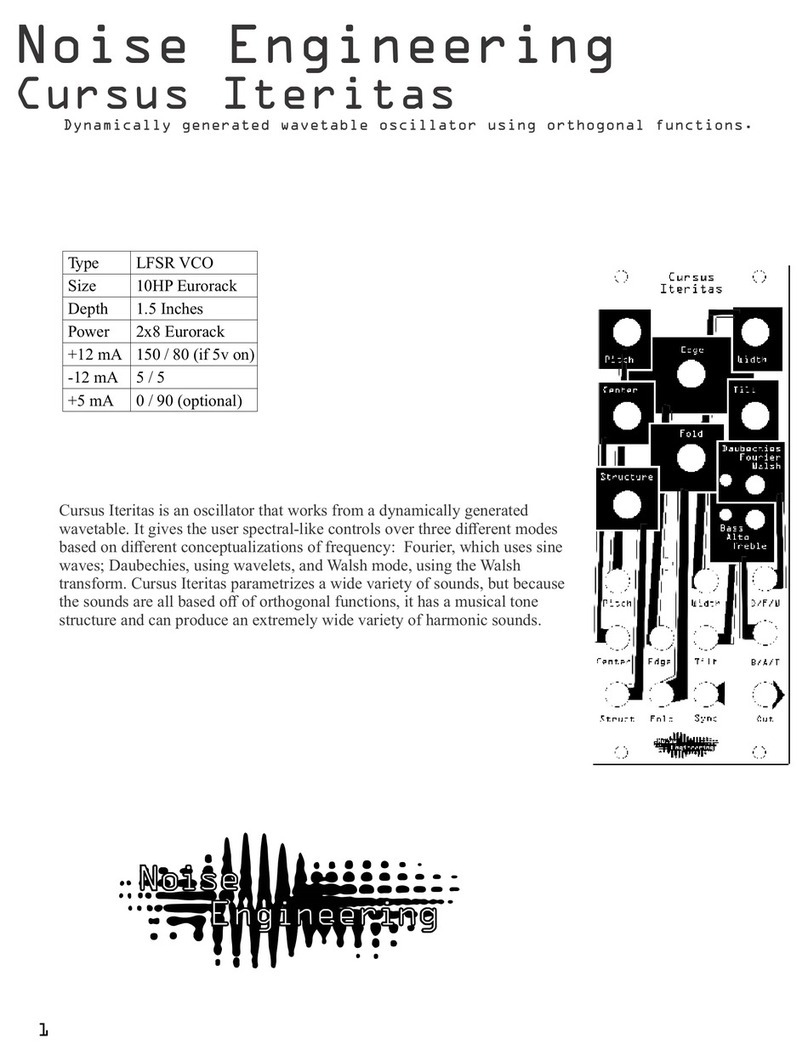
Noise Engineering
Noise Engineering Cursus Iteritas User manual
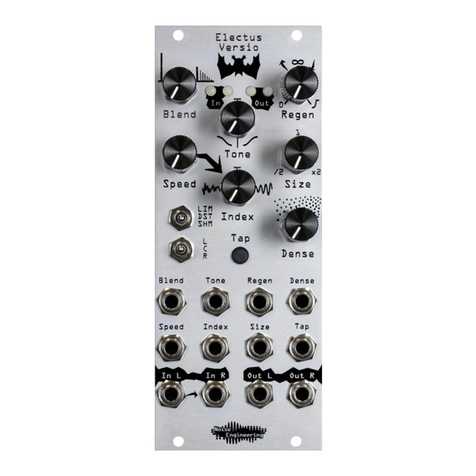
Noise Engineering
Noise Engineering Electus Versio User manual
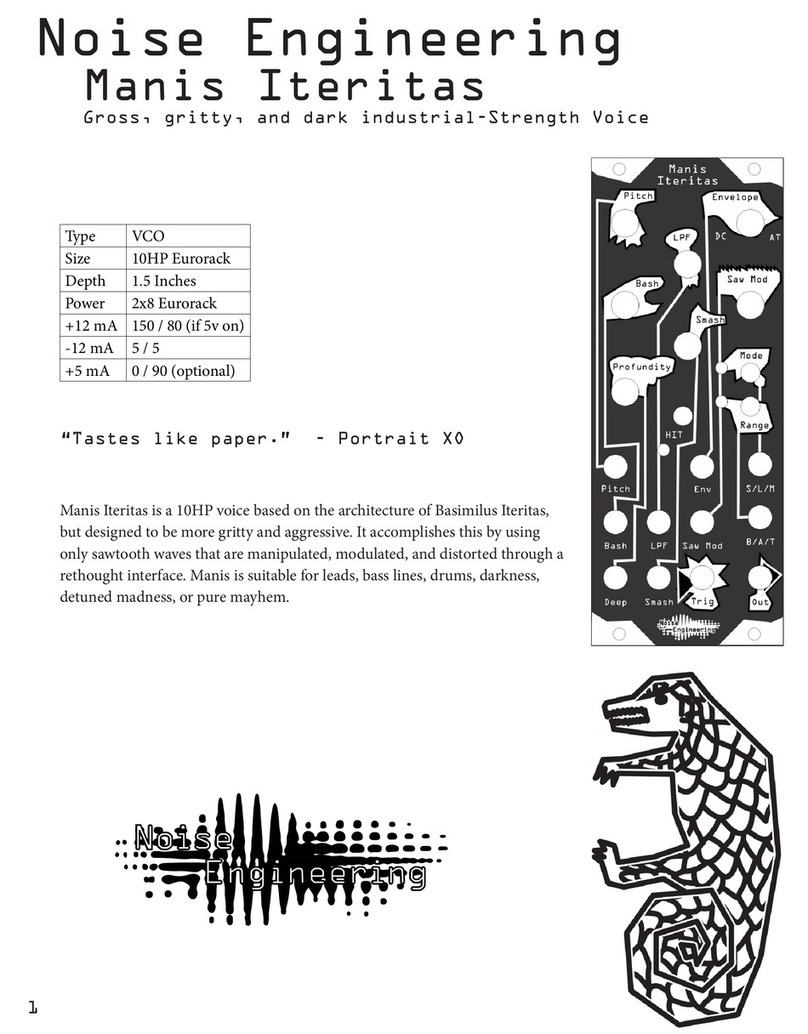
Noise Engineering
Noise Engineering Manis Iteritas User manual
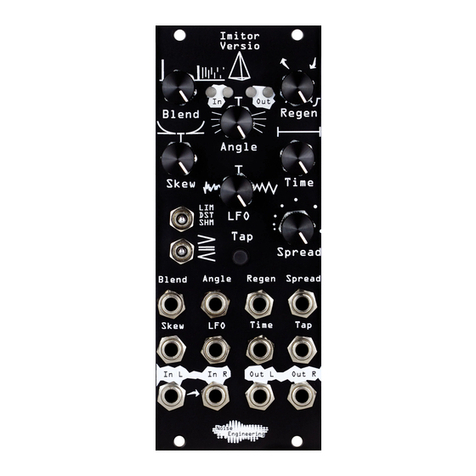
Noise Engineering
Noise Engineering Imitor Versio User manual

Noise Engineering
Noise Engineering Loquelic Iteritas Percido User manual
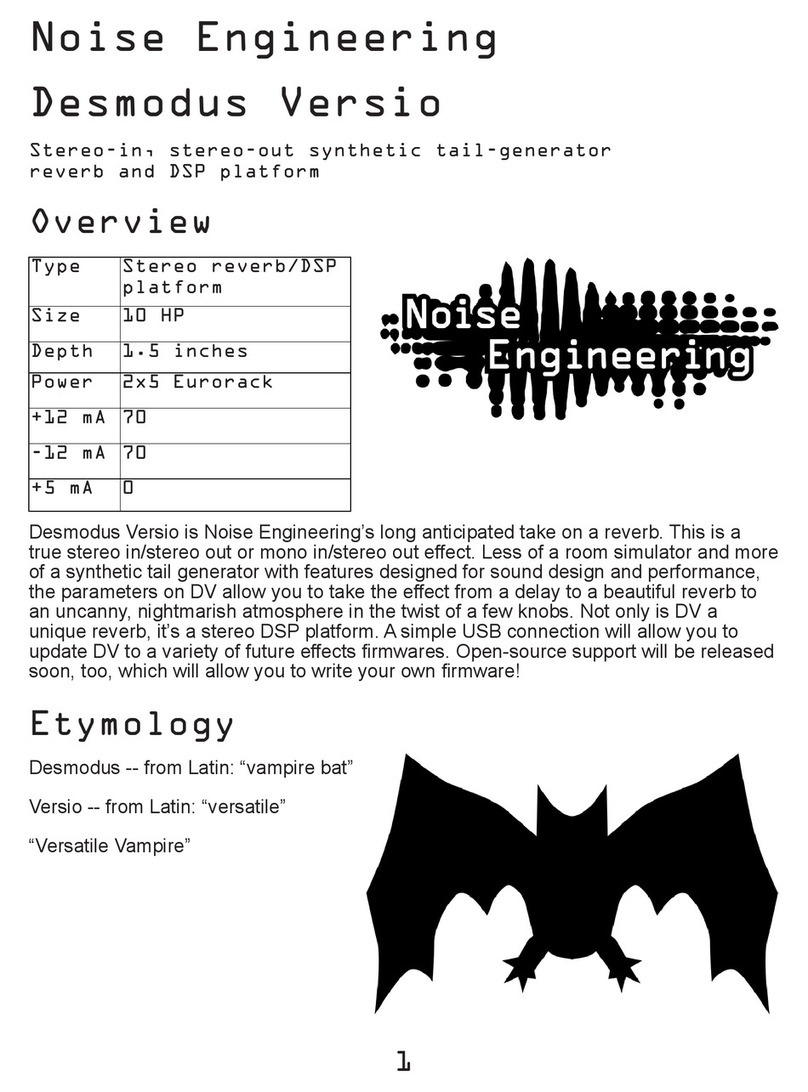
Noise Engineering
Noise Engineering Desmodus Versio User manual
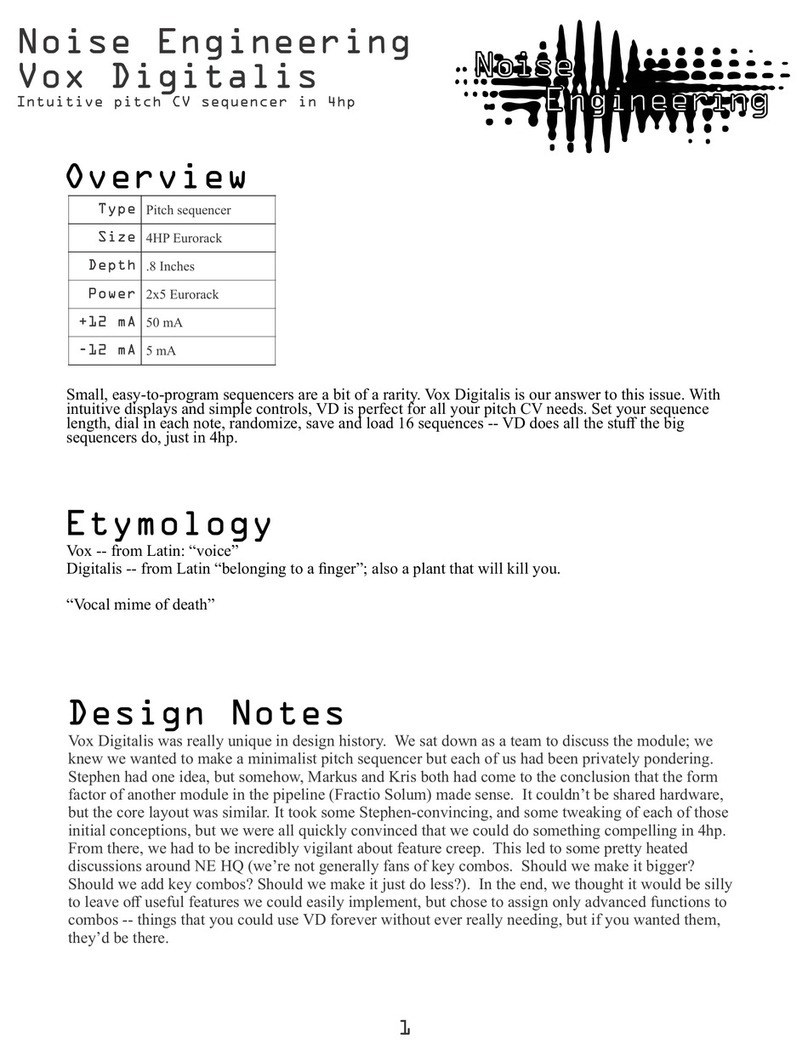
Noise Engineering
Noise Engineering Vox Digitalis User manual
